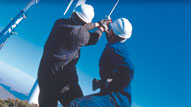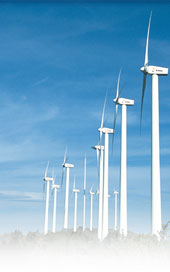5 Control systems
Further improvements in the cost-effectiveness of wind turbines drives designers towards larger, lighter, more flexible structures, in which more 'intelligent' control systems play an important part in actively reducing the applied structural loads.
This strategy of "brain over brawn" will therefore avoid the need for wind turbines to simply withstand the full force of the applied loads through the use of stronger, heavier and therefore more expensive structures. To reach this point it is now necessary to demonstrate these load reductions in full-scale field tests on a well-instrumented turbine. These control techniques can then be used with more confidence in the design of new, larger and innovative turbines, which are to be studied in this project.
As the penetration of wind energy increases, real issues are
already arising relating to the control of the electrical network
and its interaction with wind farms. These issues must be
resolved before the penetration of wind power can increase
further.
The objectives and activities of this work package are the
following:
• the further development of control algorithms for wind
turbine load reduction, of the sensors and actuators which are
required for the algorithms to be effective, of efficient methods
of adjusting and testing controllers, and the application of these
techniques to new larger and innovative turbines;
• the investigation and evaluation of different load
estimation algorithms, using various sets of available sensor
signals;
• the incorporation of promising structures to load reducing
controller algorithms;
• the identification of potential problems to overcome when
taking into account fault prediction information in controller
dynamics;
• field tests to demonstrate that the load reductions and
estimated loads can be achieved reliably, so that future designs
can take advantage of the implied reduction in capital costs;
• the development of wind turbine and wind farm control
techniques aimed at increasing the acceptable penetration of wind
energy, by allowing wind turbines to ride through network
disturbances, and to contribute to voltage and frequency stability
and overall reliability of the network.
Deliverables
Click here to see the intermediary results of this Work Package.
Leaflet
Work package leader
• Garrad Hassan and Partners Ltd.
Work package partners
• Risø National Laboratory - DTU (DK)
• Energy research Centre of the Netherlands - ECN
(NL)
• Institute for Solar Energy supply Technology - ISET
(D)
• GE Wind Energy GmbH (D)
• Fiberblade Eólica S.A. (E)
• LM Glasfiber A.S. (DK)
• Repower Systems AG (D)
• Ecotècnia S.C.C.L. (E)
Contact details
Dr. Ervin Bossanyi
Garrad Hassan and Partners Ltd.
St Vincent's Works, Silverthorne Lane, Bristol, BS2 0QD
United Kingdom
Tel: +44 (0)117 972 9900
[email protected]


